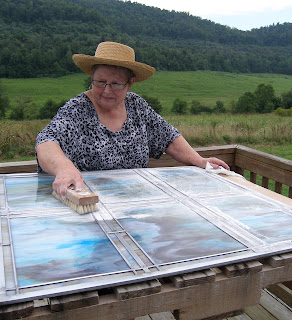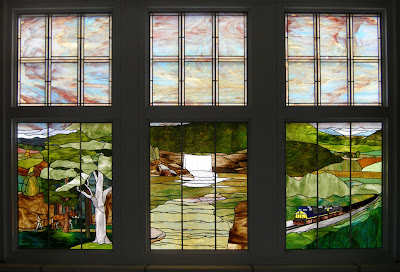During the summer of 2010, I was asked to build stained glass windows for the front of the Whitley County Judicial Center in Williamsburg, Kentucky. Five themes important to the economy of the area were requested: Cumberland Falls, CSX railroad, coal, logging (with mules), and farming. I visualized the themes combined as a summer landscape, and prepared a concept image which was approved by the project committee.
Planning and designing took place over the coming months. Many photographs were taken around the county, older ones referenced, and research visits were made to various individuals, including the mules in full gear pulling a log. Tools and supplies were systematically gathered into the studio space in preparation for full time work to begin early in May of 2011. The bulk of the construction of the six panels took place from then through October.
I chose Kokomo Opalescent as the primary source for glass, knowing that they hand make beautiful art glass, have been doing so for 150 years, and matching glass will be available if there should ever be future need of it. Touring the factory in Indiana was an adventure in itself, observing the process, meeting the workers, and then choosing from the thousands of large sheets of glass, each singularly beautiful, those that would be shipped to Williamsburg--not a simple task! I looked for special colors and textures to express the various sections and themes.
The method of construction used in the three lower panels is one pioneered by Tiffany. It is a modified jeweler's technique of joining parts by running a solid line of 60/40 tin/lead solder over adhesive-backed copper foil edging that is burnished around each piece of glass. This method allows for more intricate designs using smaller, less geometric pieces of glass. The finished piece is more tightly sealed and more rigid than leaded glass. The older traditional technique consists of setting pieces of glass into H-shaped lead came, then soldering only at the joints. Deterioration of structural lead came due to time and exposure to the elements often brings about the demise of otherwise still beautiful antique stained glass windows. Copper foil constructed pieces are more likely to remain intact for longer periods of time. The three upper sky panels, more repetitive and geometric, are constructed in the traditional way, using zinc came instead of solid lead.
Glass is a fascinating medium. When transparent or translucent, its appearance is greatly determined by the quality and intensity of light that passes through it or is reflected off its surface. Its colors are permanent, and can be dazzling in effect. It transforms a space by its presence. Working in glass and its peripherals, as with some other media, can be hazardous and challenging. The worker comes to understand and respect the different personalities of different glasses and of glass in general. From its elemental beginnings, through molten lava-taffy, to cool and smooth, it is at once strong and fragile, commanding respect and appreciation.
In some cultures, out of reverence for God, who is the only perfect creator, artisans deliberately include some type of imperfection in their work. The first completed of the three lower pictorial panels has such a line. By the time the third panel was finished, the notion of perfection had become amusing. At last seeing the panels sealed into their places was very gratifying, but I expect there will forever be pieces and parts that I would move around or change if possible, lines that could have taken a different path, etc.
It is my hope that the windows will survive long as a source of some measure of joy and wonder for those who enter into their space. From my perspective, their creation has been a massive undertaking, with timely completion made possible by the help of many. My thanks go to the project committee for the opportunity to build the windows; to my son, who directed me to new space; to my daughter who encouraged and offered good ideas; to my granddaughter who expands the horizon, and to everyone else who lifted, arranged, encouraged, got their hands dirty, bled, and otherwise assisted. My particular appreciation is for Kay.
("Older Posts" at the end of this page shows the finished installation.)


































